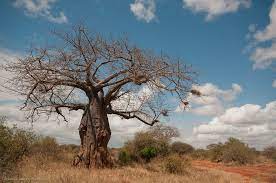Science News Roundup: Study reveals history and oceanic voyages of remarkable baobab tree; Sea otters get more prey and reduce tooth damage using tools
A new study resolves this, based on genomic analyses of all eight recognized species as well as ecological and geological data, so the baobab's story can finally be told. Sea otters get more prey and reduce tooth damage using tools Humans are not alone in the use of tools.

Following is a summary of current science news briefs.
Study reveals history and oceanic voyages of remarkable baobab tree
The baobab tree is a distinctive sight on the landscape. When its contorted branches are leafless during the dry season, they resemble jumbled roots emanating from a thick trunk, making it appear as if someone had yanked the tree from the ground, flipped it on its head and jammed it back into the earth. Hence one of its nicknames: the "upside down tree." But the origins and history of the baobab - found in Madagascar and parts of Africa and Australia - have been something of a mystery. A new study resolves this, based on genomic analyses of all eight recognized species as well as ecological and geological data, so the baobab's story can finally be told.
Sea otters get more prey and reduce tooth damage using tools
Humans are not alone in the use of tools. Chimpanzees, for instance, crack nuts with stones and use sticks to get at tasty termites. Dolphins are known to employ sponges to protect their beaks while foraging. And a Galapagos Islands finch uses cactus spines to dig grubs out of holes. Sea otters also are members of the animal kingdom's tool-wielding club. And a new study offers a fuller understanding of the tool use - utilizing rocks and other objects to break open hard prey - by these marine mammals. It lets the otters eat certain larger prey and reduces their tooth damage by cutting down on their chomping down on hard shells, with females using tools more than males, perhaps to compensate for their smaller body size and weaker bite force, researchers found.
(With inputs from agencies.)
- READ MORE ON:
- Africa
- Australia
- Galapagos
- Madagascar
ALSO READ
South Africa urges UN's top court to order cease-fire in Gaza to shield citizens in Rafah
UNESCO, Korea launch Better Education for Africa's Rise (BEAR III) Project
South Africa's election could bring a defining moment — and new complications. Here's what to know
Israel will respond to genocide charges at UN court after South Africa urgently requests cease-fire
Rescue efforts halted after South African building collapse where 33 died










